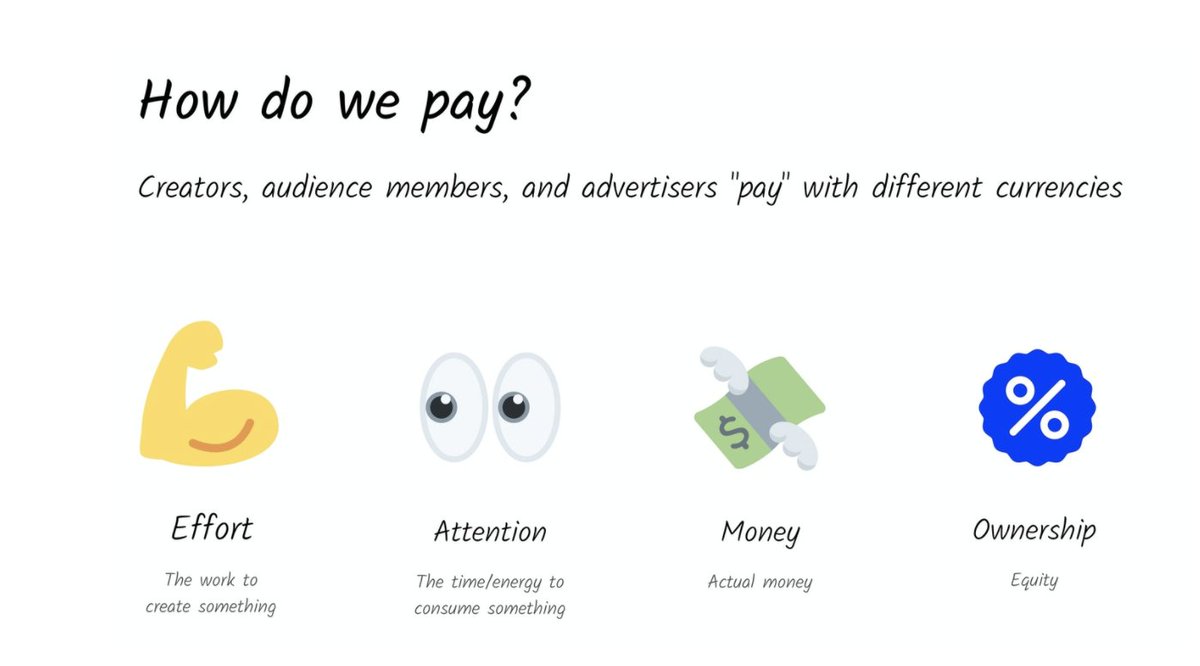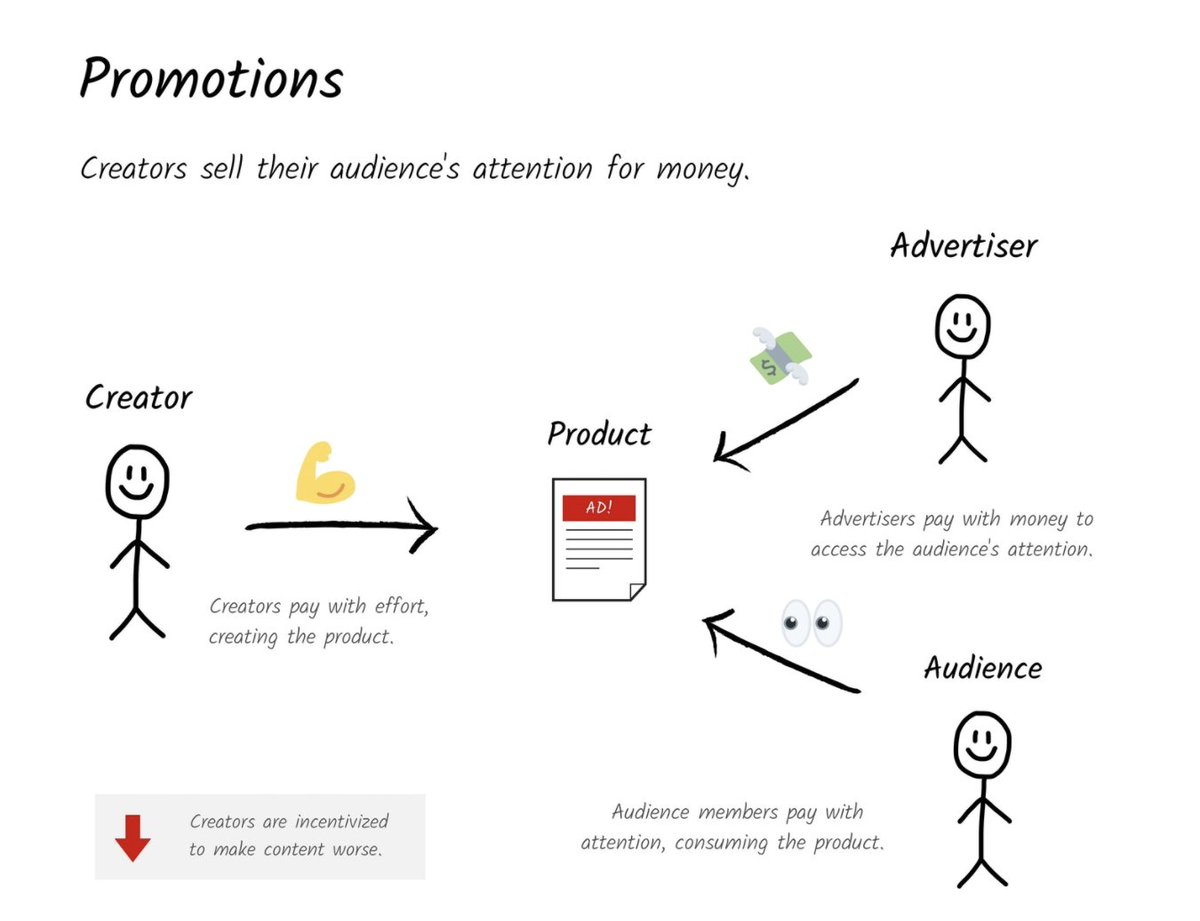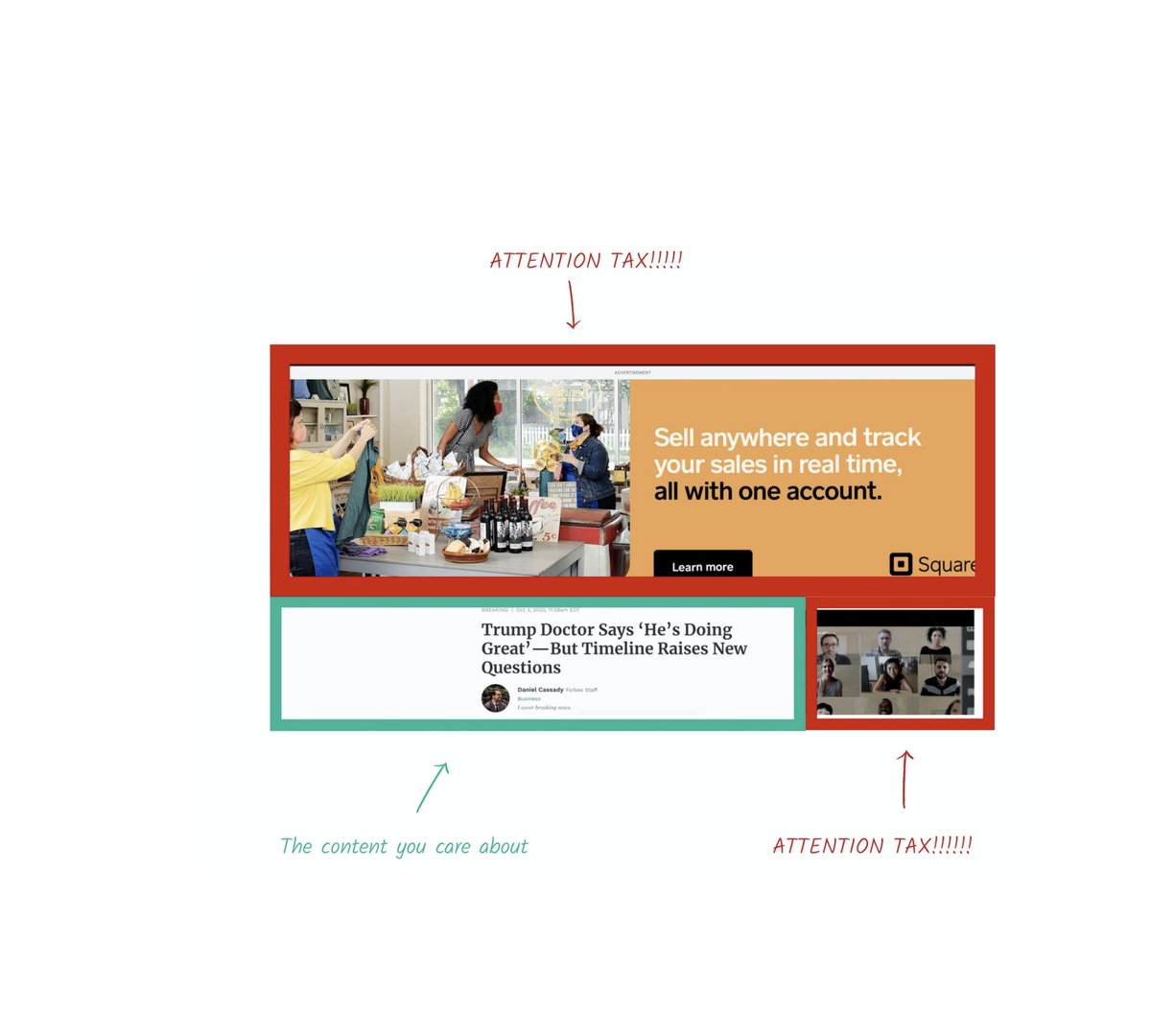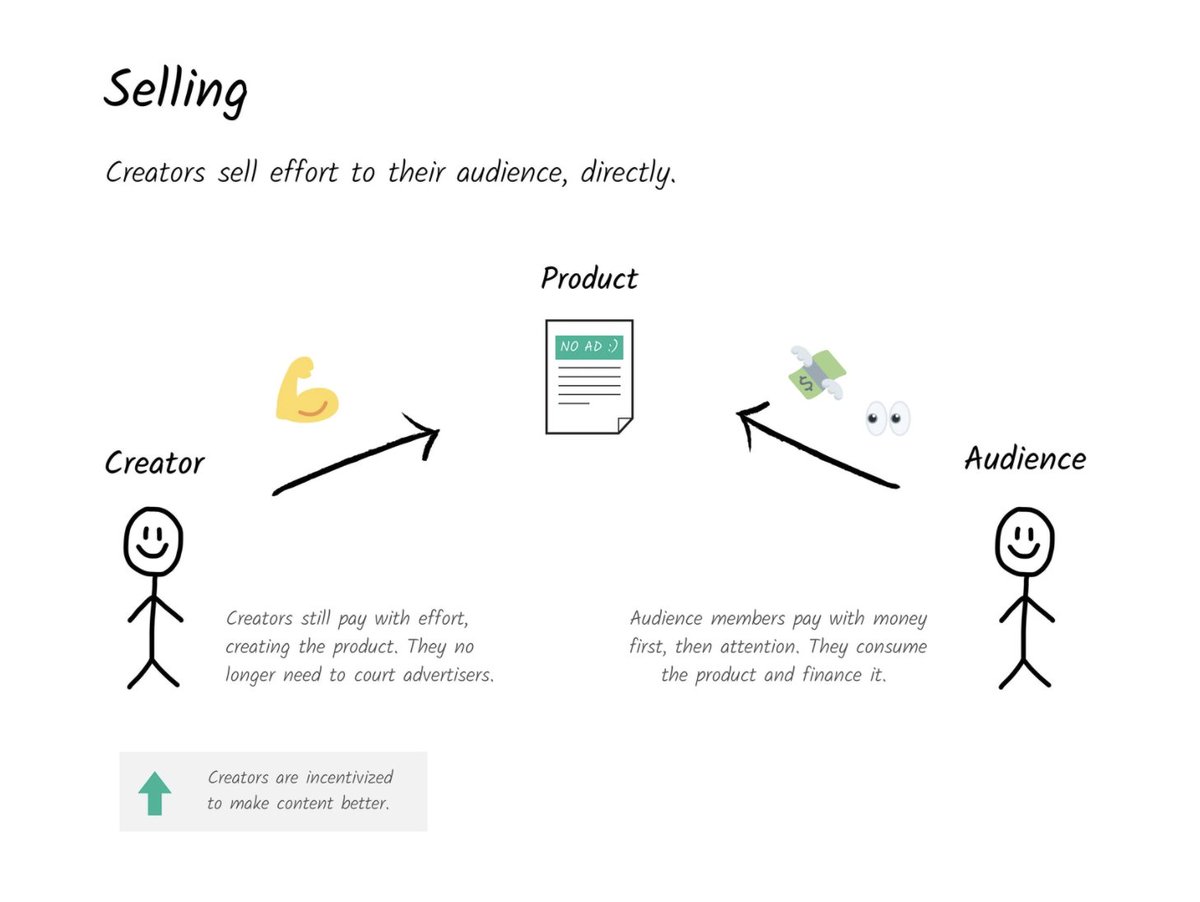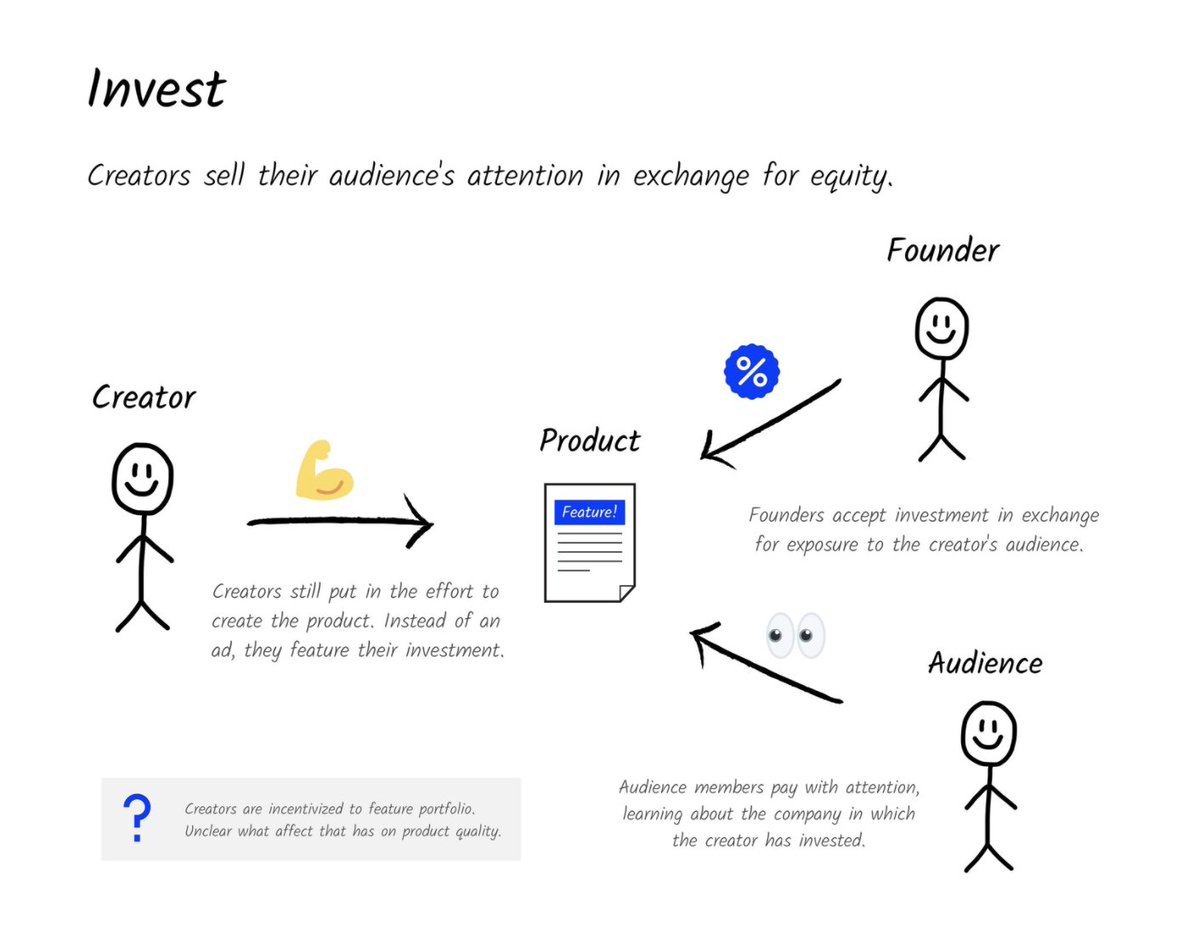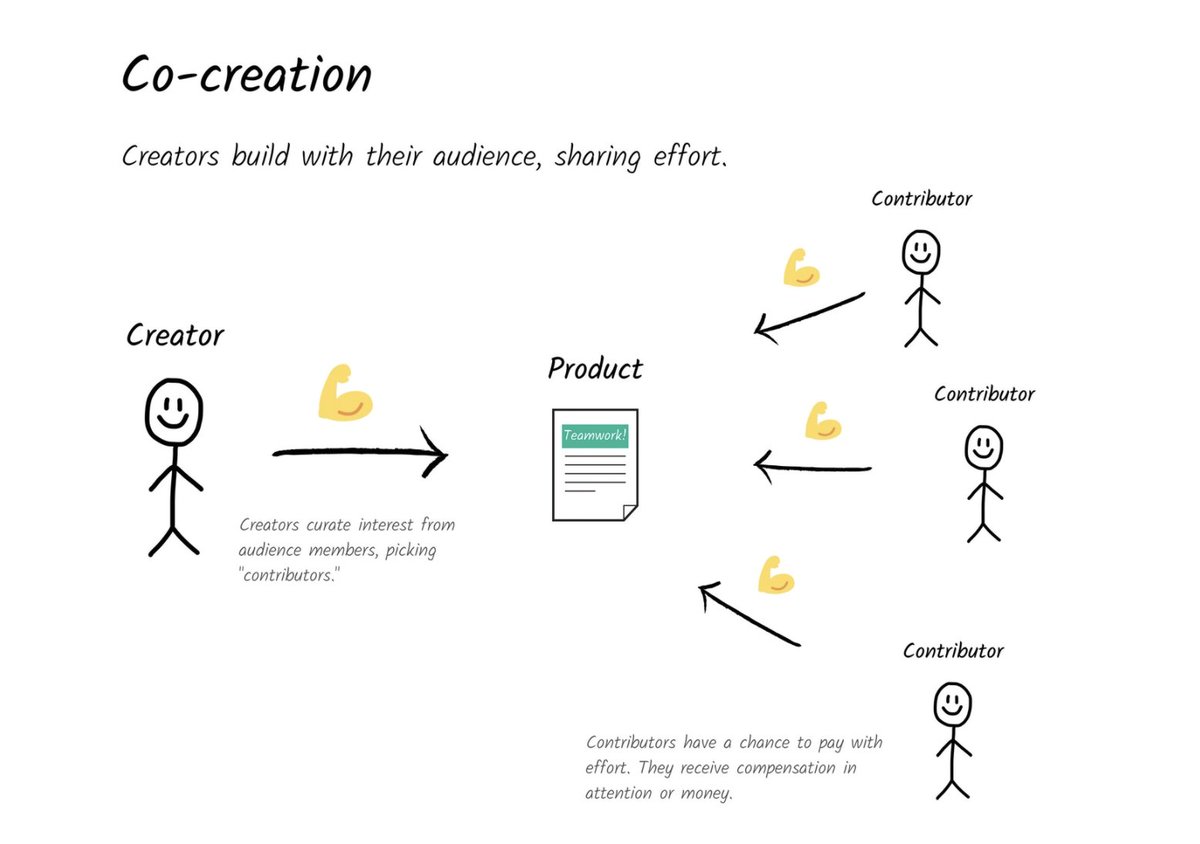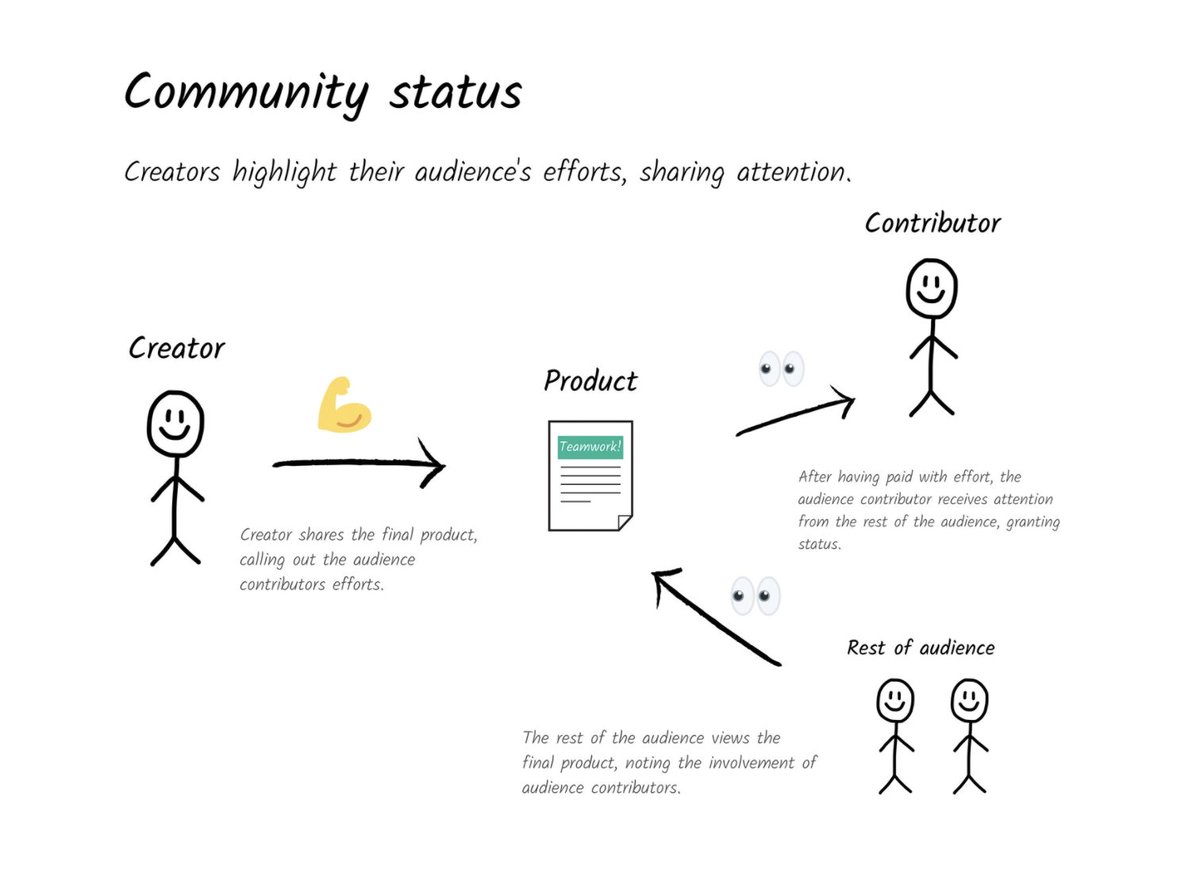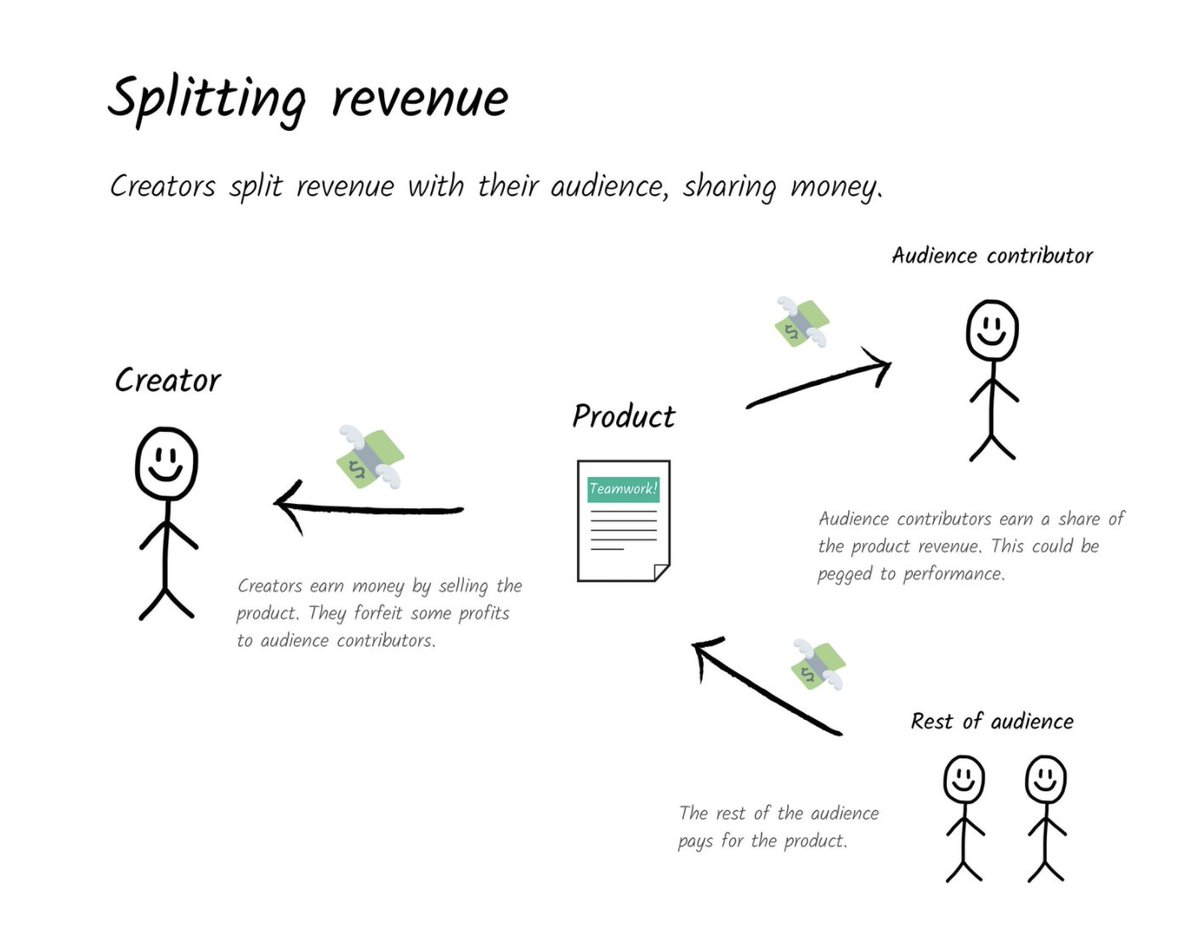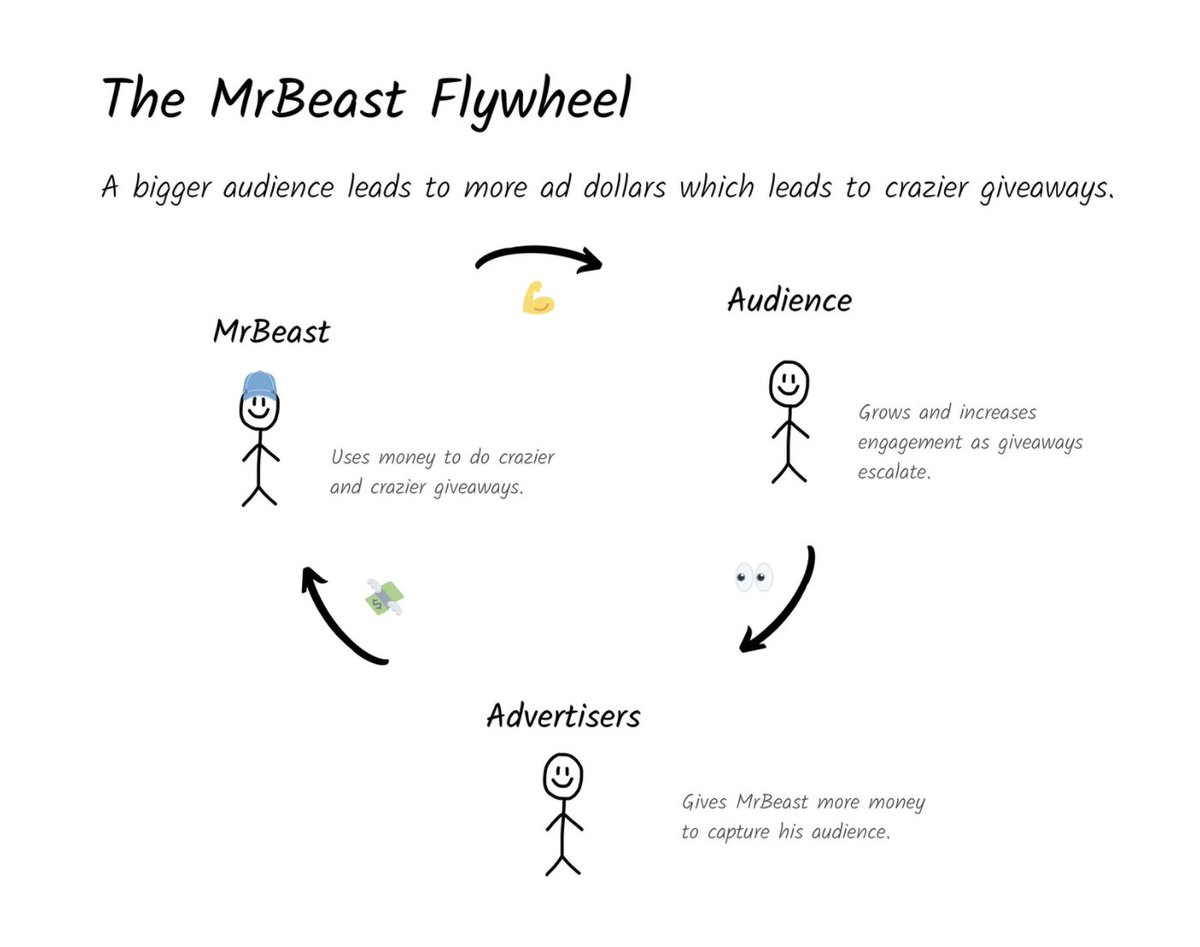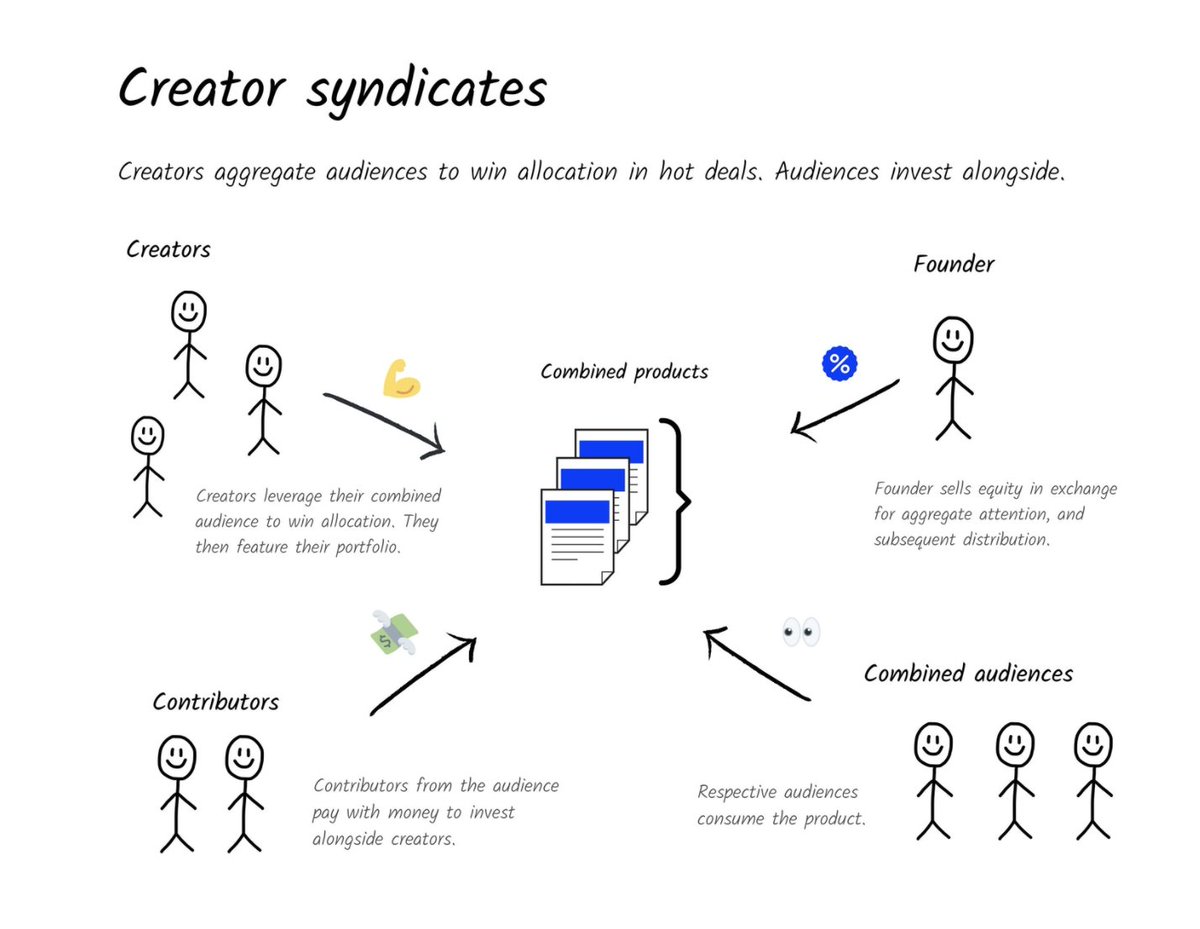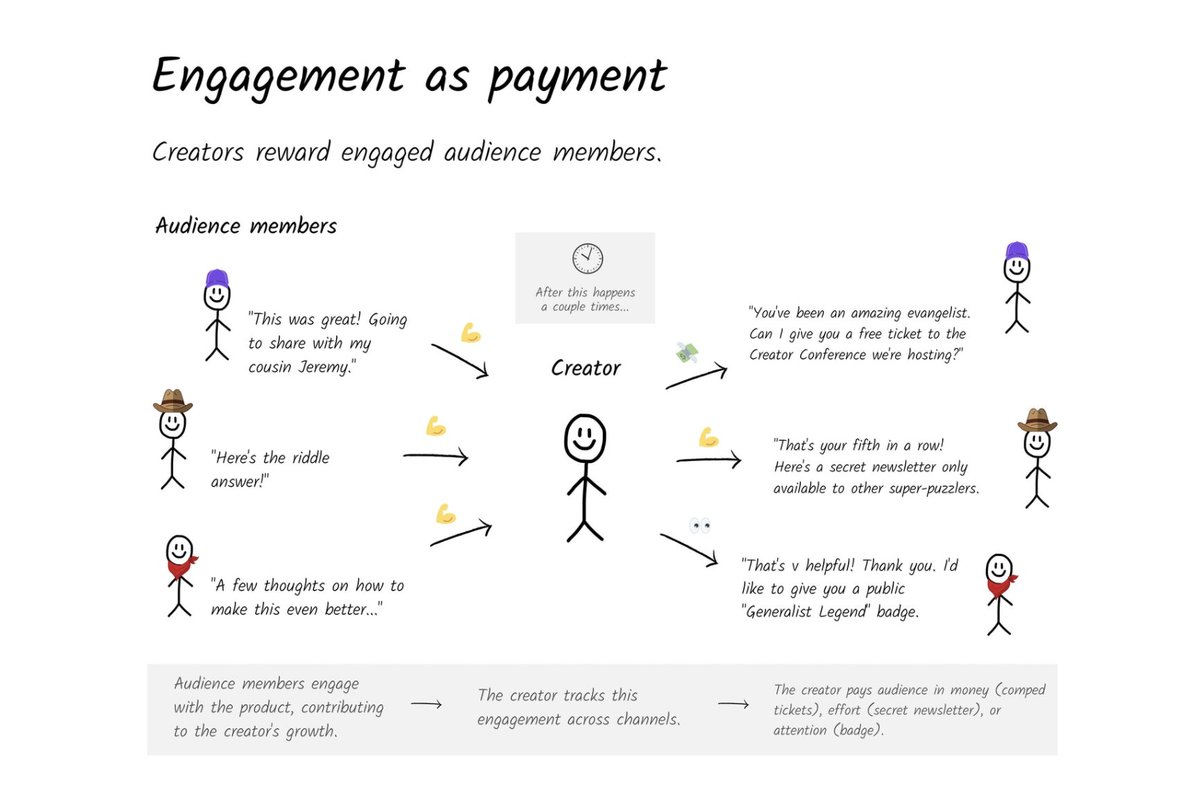What do creators sell?
This is Part 2 of "Audience and Wealth," a series about the creator economy.
- Sharing profits w/ an audience
- Borrowing from Reddit
- The @MrBeastYT Flywheel
It& #39;s the most-positively received piece I& #39;ve ever written. Thread https://abs.twimg.com/emoji/v2/... draggable="false" alt="👇" title="Rückhand Zeigefinger nach unten" aria-label="Emoji: Rückhand Zeigefinger nach unten"> https://thegeneralist.substack.com/p/audience-and-wealth-part-ii">https://thegeneralist.substack.com/p/audienc...
https://abs.twimg.com/emoji/v2/... draggable="false" alt="👇" title="Rückhand Zeigefinger nach unten" aria-label="Emoji: Rückhand Zeigefinger nach unten"> https://thegeneralist.substack.com/p/audience-and-wealth-part-ii">https://thegeneralist.substack.com/p/audienc...
This is Part 2 of "Audience and Wealth," a series about the creator economy.
- Sharing profits w/ an audience
- Borrowing from Reddit
- The @MrBeastYT Flywheel
It& #39;s the most-positively received piece I& #39;ve ever written. Thread
Quick note.
This was a 2-part series. You don& #39;t have to read Part 1 to understand what& #39;s going on, but here& #39;s the summary if you& #39;re interested. https://twitter.com/mariodgabriele/status/1313229949965393922">https://twitter.com/mariodgab...
This was a 2-part series. You don& #39;t have to read Part 1 to understand what& #39;s going on, but here& #39;s the summary if you& #39;re interested. https://twitter.com/mariodgabriele/status/1313229949965393922">https://twitter.com/mariodgab...
1
Every piece of content has stakeholders:
- The Creator
- The Audience
- The Advertiser
- (The Founder)
Their presence depends on the business model the creator uses.
Every piece of content has stakeholders:
- The Creator
- The Audience
- The Advertiser
- (The Founder)
Their presence depends on the business model the creator uses.
2
These stakeholders each "pay" with different currencies. The 4 currencies:
1 - Effort. The act of making a product.
2 - Attention. The act of consuming a product.
3 - Money. Cash.
4 - Ownership. Equity in an entity.
These are applied differently in different models.
These stakeholders each "pay" with different currencies. The 4 currencies:
1 - Effort. The act of making a product.
2 - Attention. The act of consuming a product.
3 - Money. Cash.
4 - Ownership. Equity in an entity.
These are applied differently in different models.
3
Advertising-based models work as follows:
- Creators pay with effort, making the product.
- Audience members pay with attention, consuming it.
- Advertisers buy that attention with money.
The upside? An audience gets access to the product w/o paying money.
Advertising-based models work as follows:
- Creators pay with effort, making the product.
- Audience members pay with attention, consuming it.
- Advertisers buy that attention with money.
The upside? An audience gets access to the product w/o paying money.
4
There is a downside.
Though they don& #39;t pay in money, the audience does pay in attention. Ads act as a tax.
This creates tension between creators and audience: creators want to sell as many ads as possible w/o losing trust while audience want as few as possible.
There is a downside.
Though they don& #39;t pay in money, the audience does pay in attention. Ads act as a tax.
This creates tension between creators and audience: creators want to sell as many ads as possible w/o losing trust while audience want as few as possible.
5
Direct sales and subscriptions remove the advertiser.
- Creators pay with effort, creating the product.
- Audience pays with money first, attention second.
The benefit is that the audience& #39;s attention is not taxed, but those that can& #39;t pay with money are excluded.
Direct sales and subscriptions remove the advertiser.
- Creators pay with effort, creating the product.
- Audience pays with money first, attention second.
The benefit is that the audience& #39;s attention is not taxed, but those that can& #39;t pay with money are excluded.
6
Creators that build wealth through ownership add a stakeholder: the founder.
- Creators promote their investment in product.
- Founders accept money to access the audience.
- Audience members consume information about the co.
This is model is used by VCs and angels.
Creators that build wealth through ownership add a stakeholder: the founder.
- Creators promote their investment in product.
- Founders accept money to access the audience.
- Audience members consume information about the co.
This is model is used by VCs and angels.
7
These are the traditional models. How can we change them? What can be made better?
I believe that creators that solve for *sharing* with their audience will win. Sharing what?
- Effort
- Attention
- Money
- Ownership
These are the traditional models. How can we change them? What can be made better?
I believe that creators that solve for *sharing* with their audience will win. Sharing what?
- Effort
- Attention
- Money
- Ownership
8
How do you share effort?
You bring your community to be a part of the building process. This elevates audience members to *contributors.*
They benefit by getting to apply their expertise, network, and learn.
How do you share effort?
You bring your community to be a part of the building process. This elevates audience members to *contributors.*
They benefit by getting to apply their expertise, network, and learn.
9
How do you share attention?
You shift focus away from you, the creator, towards engaged audience members.
- Great comment? Call it out.
- Helped with something? Same.
Reddit does this well, on-platform, giving "awards" for popular comments. Creators need better tools.
How do you share attention?
You shift focus away from you, the creator, towards engaged audience members.
- Great comment? Call it out.
- Helped with something? Same.
Reddit does this well, on-platform, giving "awards" for popular comments. Creators need better tools.
10
How do you share money?
You split revenue. One way to align incentives on new products is to give audience members access to some of the upside.
Let& #39;s say I launch a course. Would it be motivating to share 5% of revenue w/ the most engaged community members?
cc @stir
How do you share money?
You split revenue. One way to align incentives on new products is to give audience members access to some of the upside.
Let& #39;s say I launch a course. Would it be motivating to share 5% of revenue w/ the most engaged community members?
cc @stir
11
How do you share ownership?
Syndicates. Rather than using your audience to win allocation in startups and invest directly, you can run a syndicate and give your community the chance to invest alongside you.
How do you share ownership?
Syndicates. Rather than using your audience to win allocation in startups and invest directly, you can run a syndicate and give your community the chance to invest alongside you.
12
There are some fascinating new models coming to the fore. Three key ideas:
- Content escalation (à la @MrBeastYT)
- Creator syndicates
- Engagement as payment
There are some fascinating new models coming to the fore. Three key ideas:
- Content escalation (à la @MrBeastYT)
- Creator syndicates
- Engagement as payment
13
. @MrBeastYT has the most interesting model in the creator economy.
Rather than levying an attention tax on his audience, he uses ad dollars to *escalate* the content itself.
This fundamentally changes the relationship between creators, audience members, and advertisers.
. @MrBeastYT has the most interesting model in the creator economy.
Rather than levying an attention tax on his audience, he uses ad dollars to *escalate* the content itself.
This fundamentally changes the relationship between creators, audience members, and advertisers.
14
A case study.
The video below is sponsored by @DragonCityGame. Instead of a generic s/o, @MrBeastYT creates a game based on the sponsor. Audience members win money by playing.
Why is this so powerful? It& #39;s to do with sharing. https://www.youtube.com/watch?v=Vl3swga-Xrk">https://www.youtube.com/watch...
A case study.
The video below is sponsored by @DragonCityGame. Instead of a generic s/o, @MrBeastYT creates a game based on the sponsor. Audience members win money by playing.
Why is this so powerful? It& #39;s to do with sharing. https://www.youtube.com/watch?v=Vl3swga-Xrk">https://www.youtube.com/watch...
15
With this model, @MrBeastYT shares *three* currencies with audience members:
- Effort. They contribute to creating the video.
- Attention. They get status by being featured.
- Wealth. They win actual money.
It& #39;s the most distributive approach in the creator economy.
With this model, @MrBeastYT shares *three* currencies with audience members:
- Effort. They contribute to creating the video.
- Attention. They get status by being featured.
- Wealth. They win actual money.
It& #39;s the most distributive approach in the creator economy.
16
The result? An extremely powerful flywheel.
As audience grows, so does ad budget, which allows @MrBeastYT to create bigger and bolder giveaways, which in turn attracts a bigger audience.
(Round and round we go)
The result? An extremely powerful flywheel.
As audience grows, so does ad budget, which allows @MrBeastYT to create bigger and bolder giveaways, which in turn attracts a bigger audience.
(Round and round we go)
17
A different model that I expect to come to the fore?
Creator syndicates.
Most syndicates suffer from adverse selection. Often, getting access means that other VCs have passed.
Creators can mitigate this by banding together, creating an effective, high-signal syndicate.
A different model that I expect to come to the fore?
Creator syndicates.
Most syndicates suffer from adverse selection. Often, getting access means that other VCs have passed.
Creators can mitigate this by banding together, creating an effective, high-signal syndicate.
18
Ex: a tech newsletter writer& #39;s syndicate.
I canv visualize a Voltron of @CaseyNewton @Alex_Danco @eugenewei @ByrneHobart @juliey4 snaffling allocation from traditional VCs.
- Founders would reach a large, vetted audience.
- Readers could invest in competitive deals.
Ex: a tech newsletter writer& #39;s syndicate.
I canv visualize a Voltron of @CaseyNewton @Alex_Danco @eugenewei @ByrneHobart @juliey4 snaffling allocation from traditional VCs.
- Founders would reach a large, vetted audience.
- Readers could invest in competitive deals.
19
A final thought (and free startup idea).
Creators need to find ways to enable "engagement as payment."
Those audience members that are most engaged w/ what you& #39;re doing should receive perks:
- Exclusive events
- Extra content
- Price deductions
- Public awards/badges
A final thought (and free startup idea).
Creators need to find ways to enable "engagement as payment."
Those audience members that are most engaged w/ what you& #39;re doing should receive perks:
- Exclusive events
- Extra content
- Price deductions
- Public awards/badges
20
It& #39;s not possible for a creator to track audience interactions at scale. But software could, ingesting info from Twitter, ConvertKit, LinkedIn, to let you know who you should be giving more attention to.
You could automate identification the rewards themselves.
It& #39;s not possible for a creator to track audience interactions at scale. But software could, ingesting info from Twitter, ConvertKit, LinkedIn, to let you know who you should be giving more attention to.
You could automate identification the rewards themselves.
Creators need to share.
In the process, they& #39;ll find it easier to break the traditional boundaries between audience members, advertisers, founders, and creators, themselves. https://thegeneralist.substack.com/p/audience-and-wealth-part-ii">https://thegeneralist.substack.com/p/audienc...
In the process, they& #39;ll find it easier to break the traditional boundaries between audience members, advertisers, founders, and creators, themselves. https://thegeneralist.substack.com/p/audience-and-wealth-part-ii">https://thegeneralist.substack.com/p/audienc...
PS —
If you& #39;re building something that enables this behavior. I& #39;d love to be a guinea pig. And if you& #39;re looking to raise, you should talk to...
@ljin18
@blakeir
@daveambrose
@JoshConstine
@TurnerNovak
^ no order, all https://abs.twimg.com/emoji/v2/... draggable="false" alt="💯" title="Hundert Punkte Symbol" aria-label="Emoji: Hundert Punkte Symbol">
https://abs.twimg.com/emoji/v2/... draggable="false" alt="💯" title="Hundert Punkte Symbol" aria-label="Emoji: Hundert Punkte Symbol">
If you& #39;re building something that enables this behavior. I& #39;d love to be a guinea pig. And if you& #39;re looking to raise, you should talk to...
@ljin18
@blakeir
@daveambrose
@JoshConstine
@TurnerNovak
^ no order, all

 Read on Twitter
Read on Twitter